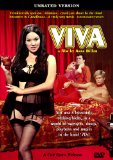Welcome to 1972, when the sexual revolution is simultaneously in full swing, yet also showing signs of exhaustion (all that swinging can wear a body down, don’t you know). Barbi (Anna Biller) is a model housewife who is awakening to the feeling that there is a world outside her four walls. When she and her husband have a falling out, she hooks up with her more extroverted neighbour Sheila (Bridget Brno), who is also in the midst of a marriage crisis, and the two of them seek new love by taking work at an escort agency. What follows is a picaresque series of encounters, with nary a sexploitation angle ignored.
This film is a textbook definition of “labour of love.” Anna Biller no only stars, she directed, scripted, co-produced, edited, and took care of production and costume design. The latter took ages, since she wanted the costumes to match the decor, but the result was worth it – no small part of the film’s humour comes from its rigorous fidelity to the worst of seventies’ sense of aesthetics. Biller has recreated the classic sexploitation film down to the smallest detail. There are just enough winks to the audience to acknowledge the passage of time (and there is one address to the camera, describing the era as a fleeting utopia for the male of the species, that is as incisive as it is hilarious). The performances perfectly nail their models, capturing stilted, unnatural expressions and their forced enthusiasm. But no matter how much fun is poked at those bygone films, Viva also radiates an enormous love for them. As funny as the movie is, though, at 120 minutes, it is simply too long, and the pace is too measured. Lost of fun, all the same.
Audio
This is a very low-budget little film, so its sound design isn’t terribly elaborate. That isn’t to say that it doesn’t do some nice things with music – it does, with some pretty damn funny song-and-dance numbers. But outside of said music, the soundtrack is pretty simple. Still, the score is handled well by the 2.0 mix, providing just enough surround to keep things interesting, and the dialogue is clear. Blessedly, it doesn’t distort during the deliberately irritating loud, braying laughs of some of the characters.
Video
As I mentioned above, the worst of the seventies is on glorious display here, and the transfer handles the fashion crimes extremely well. The colours are vibrant, even when simple human decency would hope they would be otherwise, and the image is extremely sharp. Contrasts, blacks and flesh tones are all excellent. This is a film whose luck is such that one starts to laugh even when there are no characters on-screen, and its look is carefully preserved.
Special Features
A director’s commentary would have been a wonderful thing here. Sadly, there is none, though Biller does narrate the behind-the-scenes featurette, which gives some insight into what she set out to achieve. I was, however, left wanting more. There’s a slide show in keeping with the spirit of the film, and the theatrical trailer.
Final Thoughts
The film could have been tighter, and the extras more generous, but still and all, it’s hard not to like such an eccentric, clever and carefully wrought piece.







